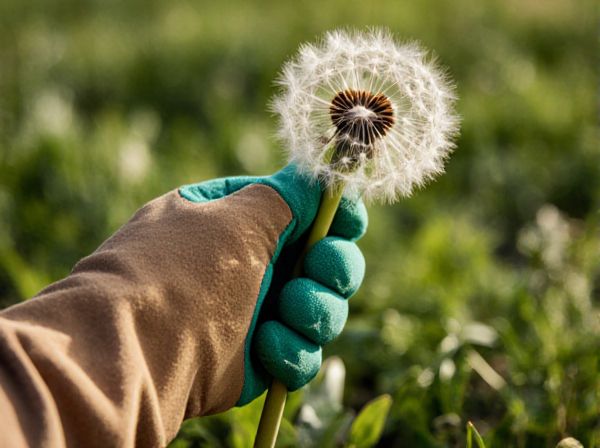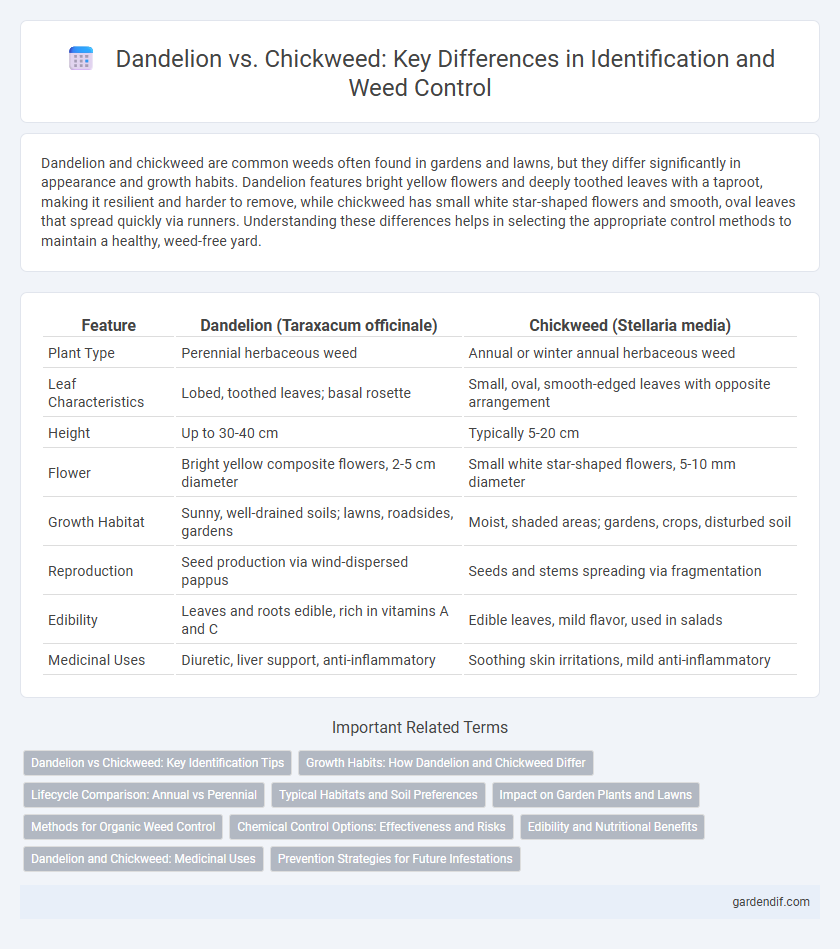
Dandelion vs chickweed Illustration
Dandelion and chickweed are common weeds often found in gardens and lawns, but they differ significantly in appearance and growth habits. Dandelion features bright yellow flowers and deeply toothed leaves with a taproot, making it resilient and harder to remove, while chickweed has small white star-shaped flowers and smooth, oval leaves that spread quickly via runners. Understanding these differences helps in selecting the appropriate control methods to maintain a healthy, weed-free yard.
Table of Comparison
| Feature | Dandelion (Taraxacum officinale) | Chickweed (Stellaria media) |
|---|---|---|
| Plant Type | Perennial herbaceous weed | Annual or winter annual herbaceous weed |
| Leaf Characteristics | Lobed, toothed leaves; basal rosette | Small, oval, smooth-edged leaves with opposite arrangement |
| Height | Up to 30-40 cm | Typically 5-20 cm |
| Flower | Bright yellow composite flowers, 2-5 cm diameter | Small white star-shaped flowers, 5-10 mm diameter |
| Growth Habitat | Sunny, well-drained soils; lawns, roadsides, gardens | Moist, shaded areas; gardens, crops, disturbed soil |
| Reproduction | Seed production via wind-dispersed pappus | Seeds and stems spreading via fragmentation |
| Edibility | Leaves and roots edible, rich in vitamins A and C | Edible leaves, mild flavor, used in salads |
| Medicinal Uses | Diuretic, liver support, anti-inflammatory | Soothing skin irritations, mild anti-inflammatory |
Dandelion vs Chickweed: Key Identification Tips
Dandelion leaves are deeply toothed with a jagged appearance, while chickweed leaves are smaller, oval, and smooth-edged. Dandelions produce bright yellow flowers that turn into fluffy seed heads, in contrast to chickweed's tiny white, star-shaped flowers. Both thrive in disturbed soil, but dandelions have thicker, long taproots, whereas chickweed spreads through soft, sprawling stems.
Growth Habits: How Dandelion and Chickweed Differ
Dandelion (Taraxacum officinale) exhibits a deep taproot system, allowing it to thrive in compacted soils and resist removal, while chickweed (Stellaria media) grows with shallow fibrous roots making it more susceptible to quick eradication. Dandelion forms rosettes with serrated leaves and produces a single yellow flower head per stem, whereas chickweed spreads rapidly via prostrate stems covered in tiny oval leaves and small white, star-shaped flowers. These contrasting growth habits influence their survival strategies and management in gardens and agricultural fields.
Lifecycle Comparison: Annual vs Perennial
Dandelion is a perennial weed with a lifecycle that allows it to survive multiple years through a robust taproot system, enabling continuous regrowth after mowing or herbicide treatment. Chickweed, on the other hand, is typically an annual weed that completes its lifecycle within one growing season, producing numerous seeds to ensure rapid spread and population renewal. The perennial nature of dandelion makes it more resilient and challenging to control compared to the annual lifecycle of chickweed, which relies heavily on timely removal before seed set.
Typical Habitats and Soil Preferences
Dandelions (Taraxacum officinale) commonly thrive in disturbed soils, lawns, gardens, and roadsides, favoring well-drained, moderately fertile soil with a pH range of 6.0 to 7.5. Chickweed (Stellaria media) prefers moist, shady habitats such as gardens, fields, and forest edges, flourishing in nutrient-rich, loamy soils with a slightly acidic to neutral pH around 5.5 to 7.0. Both weeds adapt to various environments but dandelions tolerate drier, compacted soils, while chickweed requires consistently moist conditions.
Impact on Garden Plants and Lawns
Dandelion and chickweed both compete aggressively with garden plants and lawns by drawing essential nutrients, water, and sunlight, potentially stunting growth and reducing yields. Dandelions have deep taproots that can disrupt soil structure and make removal difficult, while chickweed spreads rapidly across the soil surface, creating dense mats that smother grass and smaller plants. Managing these weeds early is crucial to maintaining healthy garden ecosystems and preserving the vitality of lawns.
Methods for Organic Weed Control
Dandelion and chickweed are common broadleaf weeds targeted in organic weed control using mulching, hand-pulling, and vinegar-based herbicides. Applying thick layers of organic mulch effectively suppresses dandelion by blocking sunlight and preventing seed germination, while chickweed's shallow roots make it susceptible to consistent hand-weeding. Organic solutions like acetic acid sprays disrupt chickweed growth without harming surrounding plants, offering an eco-friendly approach to managing both weeds in vegetable gardens and lawns.
Chemical Control Options: Effectiveness and Risks
Chemical control options for dandelion and chickweed vary in effectiveness due to differences in their biology and growth habits. Herbicides containing 2,4-D, dicamba, and glyphosate are commonly used for dandelion and provide selective broadleaf weed control, but repeated applications increase resistance risks and environmental impact. Chickweed often requires post-emergent herbicides with active ingredients like metsulfuron or atrazine for effective management, though off-target damage and soil contamination present significant risks.
Edibility and Nutritional Benefits
Dandelion leaves and chickweed both offer excellent edibility, with dandelion providing a rich source of vitamins A, C, and K, along with minerals like iron and calcium. Chickweed is known for its high vitamin C content and beneficial antioxidants, making it a nutritious wild green suited for salads and teas. Both weeds contribute to a healthy diet by supporting immune function and promoting digestive health through their fiber content.
Dandelion and Chickweed: Medicinal Uses
Dandelion and chickweed possess notable medicinal uses, with dandelion frequently employed for its diuretic properties and liver support, rich in antioxidants and vitamins A, C, and K. Chickweed is commonly used to soothe skin irritations, reduce inflammation, and promote wound healing due to its high content of vitamins and bioactive compounds. Both herbs are valued in traditional herbal medicine for their detoxifying effects and nutritional benefits, making them effective natural remedies.
Prevention Strategies for Future Infestations
Effective prevention strategies for dandelion and chickweed infestations emphasize maintaining healthy, dense turfgrass to outcompete these weeds. Applying pre-emergent herbicides during early spring can inhibit seed germination, while regular mulching in garden beds reduces chickweed establishment by limiting light exposure. Consistent monitoring and prompt removal of young weeds prevent seed spread, curbing long-term infestations.
Dandelion vs chickweed Infographic

 gardendif.com
gardendif.com